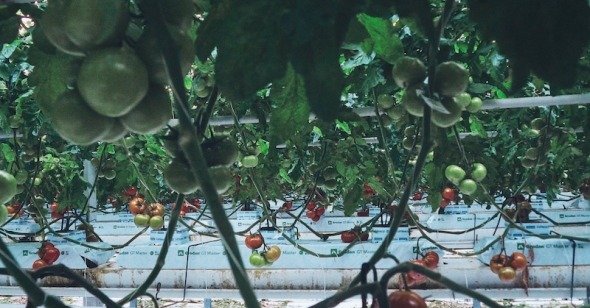Modern Times
By Nicolas Pedrero-Setzer
Agrilogistics
Dir. Gerard Ortín Castellví, Spain/U.K., no distributor
Agrilogistics screened March 16 at Museum of the Moving Image’s 2023 First Look festival.
Agrilogistics is the first short film in a planned trilogy by Gerard Ortín Castellví examining the production, distribution, and consumption of agricultural goods. Ortín nests the camera inside an industrial greenhouse in the Netherlands, countering the quick mechanical rhythms of plant-sorting machines with a patient and unmoving gaze. The synthetic quality of tulips and tomatoes ready to get shipped is reinforced by the robot arms that curate their natural look. These plants, once symbols of wildlife, are revealed as calculated feats of engineering. This push-and-pull between lively objects and their plastic formation emerges as Agrilogistics’ central conflict, as the filmmaker stages a confrontation between whirring machinery and the passive agents caught in agricultural production.
The film takes the form of a diptych. Its first half plays like a cruel cover of Chaplin’s Modern Times: all cogs and no comedy. The hypnotic humdrum is punctured in the second half, however, by the arrival of a llama traipsing through the greenhouse. The llama’s easygoing nighttime saunter in the glow of purple UV lights offers a rejuvenating counter-image, privileging slow and spontaneous movement over rapid and calculated routine. Ortín also works in counterpoints at the scale of the frame by carefully offering dialectic images throughout.
Around the time the llama first appears on screen, Ortín cuts to a shot of a stick insect atop a robotic claw. The similarities between both entities as they work their spindly legs are immediately apparent, yet the longer the camera stays on these subjects, their differences are unmistakable. As the stick insect tries to walk across the rotating mechanical claw, it’s constantly fumbling in response to the latter’s seemingly random movements. Siloed from the world in a silent close-up, their combined choreography reveals a study in contrasts, each player abiding to its own distinct internal logic.
By leaving it up to the viewer to make sense of such juxtapositions, Agrilogistics generates a space to reflect on the rampant denaturalization of agricultural products accelerated by globalization. Ortín’s focus on the packaging and commodification of these plants and vegetables demystifies the agrestal fantasy of so many of our products. At first numbing, Ortín’s images of rote mechanical production begin accruing a subtlesense of dread, appearing as an unbroken and uncaring process.
The filmmaker’s decision to not show any human laborers lends the film a sci-fi aspect, as though civilization has ceded itself over to a new machine order indifferent to the needs, considerations, and desires of its creators. The reality, however, is that workers remain essential in this process of production. Large European agricultural centers like the one depicted in Agrilogistics rely on cheap labor from countries previously belonging to the Eastern Bloc. This reality stretches across the globe with leading exporters like the United States capitalizing on Central American immigrants and Japan on Vietnamese workers. The film’s omission of identifiable human laborers speaks to, intentionally or not, the invisibility of foreign workers central to capitalism’s functionality. Though distant shadowy figures occasionally evoke the presence of people in Ortín’s film, only one scene, depicting the use of a leaf-picking device, provides a clear silhouette of someone performing maintenance. Like everything else captured by his camera—the llama, the stick insect, the robot claw, the leaf-picking device—this nondescript laborer is aestheticized, as though a product among products.
To this effect, Ortín’s camera is as democratic as it is evasive. Everything it sees is treated with the same perspective. Whether the camera’s subjects are taken as examples of technological innovation or systemic absurdity, they share an essential plasticity. Despite the fixedness of the film’s shots, none of its subjects hold steady meaning. They have all been transformed by the same logic of abstraction that replaces the beauty of flowers with a fixed price. In a Q&A following the film’s New York premiere at First Look 2023, the director revealed that the animals introduced in the film’s second half were taken from a petting zoo set up by the greenhouse’s owners on site. Even the curious llama captured by the camera is no more than a prop playing its role in global exports.
No better example of this discrepancy between appearance and effaced meaning exists than the film’s main theme: Robin Schulz’s remix of Lilly Wood and the Prick’s “Prayer in C.” On first listen, the electro-pop earworm that echoes around the greenhouse throughout the film is wholly innocuous, as though designed to be forgotten, fitting in alongside the architecturally generic space. “Prayer in C” is pure commercial noise, with predictable build-ups and drops burying its unremarkable lyrics. It is another product engineered for profit. “When seas will cover lands / And when man will be no more / Don’t think you can forgive you,” sings Lilly Wood and the Prick to the mindless production of this popular song destined for oblivion.
